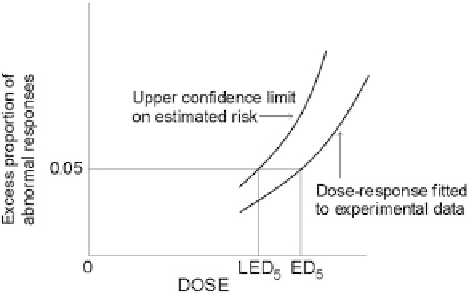Environmental Engineering Reference
In-Depth Information
Fig. 12.4
Graphical illustration of the benchmark dose approach. Adapted from WHO (
1994
)
1996
). BMD approaches are also being developed and tested in regard to acute
inhalation toxicity (Fowle et al.
1999
), to the relationship between the BMD and
the MTD (Gaylor and Gold
1998
), and to addressing statistical procedures available
for calculating BMDs and their confidence limits for non-cancer endpoints (Gaylor
et al.
1998
).
Particular advantages of the BMD approach include:
•
taking into account information from the entire dose response curve rather than
focussing on a single test dose such as is done with the NOAEL approach;
•
the use of responses within or near the experimental range versus relying on
extrapolations to doses considerably below the experimental range;
•
the use of a consistent benchmark response level that crosses a range of studies
and endpoints;
•
it is less influenced than NOAEL approaches by the arbitrary selection of doses
(Crump
1984
);
•
it is able to be rigorously described;
•
it uses all available relevant information.
Its disadvantages are that it may not be possible to define the shape of the dose
response curve because of limited dose groups or the number of animals per group
and it also requires greater statistical expertise than the NOAEL type approach (IEH
1999
).
Use of a benchmark dose with 5% extra risk provides a more data sensitive and
less model sensitive endpoint than using 1% extra risk (Klaassen
1996
, NHMRC
1999
).
When the benchmark response is within or near the experimental range of data
the corresponding values of the benchmark doses are not greatly sensitive to the
choice of the model used, but the best scientific choice of a model would be a
biologically-based mechanistic model.

Search WWH ::

Custom Search